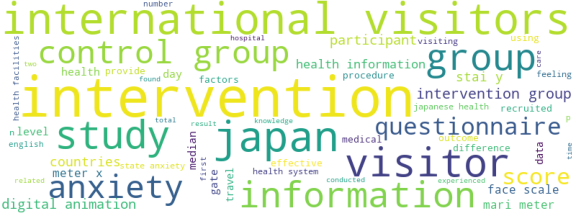| Id | 584 | |
| Author | Nishikawa M., Yamanaka M., Kiriya J., Jimba M. | |
| Title | Providing Japanese health care information for international visitors: Digital animation intervention | |
| Reference | Nishikawa M., Yamanaka M., Kiriya J., Jimba M.; Providing Japanese health care information for international visitors: Digital animation intervention ;BMC Health Services Research vol:18 issue: 1.0 page: |
|
| Link to article | https://www.scopus.com/inward/record.uri?eid=2-s2.0-85047519937&doi=10.1186%2fs12913-018-3191-x&partnerID=40&md5=5d8e0dbe17668bc17b810ceeb946432d |
|
| Abstract | Background: Over 24 million international visitors came to Japan in 2016 and the number is expected to increase. Visitors could be at a risk of illness or injury that may result in hospitalization in Japan. We assessed the effects of a four-minute digital animation titled Mari Info Japan on the level of anxiety experienced by international visitors to Japan. Methods: We conducted a non-randomized, controlled study at Narita International Airport outside Tokyo in December 2014. On the first day, we recruited international visitors for the intervention group at predetermined departure gates and, the following day, we sampled visitors for the control group at the same gates. We repeated this procedure twice over 4 days. The intervention group watched the digital animation and the control group read a standard travel guidebook in English. After receiving either intervention, they completed a questionnaire on their level of anxiety. The outcome was assessed using the Mari Meter-X, The State-Trait Anxiety Inventory Form Y (STAI-Y), and a face scale, before and immediately after the intervention. We analyzed data with Wilcoxon rank sum tests. Results: We recruited 265 international visitors (134 in the intervention group, 131 in the control group), 241 (91%) of whom completed the questionnaire. Most of them had no previous Japanese health information before arrival in Japan. The level of anxiety about health services in Japan was significantly reduced in the intervention group (Mari Meter-X median: - 5 and 0, p < 0.001 and STAI-Y median: - 3 and 0, p < 0.001). The face scale analysis showed no significant difference. Conclusions: Watching a digital animation is more effective in reducing anxiety among international visitors to Japan compared with reading a standard brochure or guidebook. Such effective animations of health information should be more widely distributed to international visitors. Trial registration: UMIN-CTR (University Hospital Medical Information Network Center Clinical Trials Registry), UMIN000015023, September 3, 2014. © 2018 The Author(s). |
|
| Keywords | Digital animation; Health information; International visitors; Japan |
Wordcloud:



